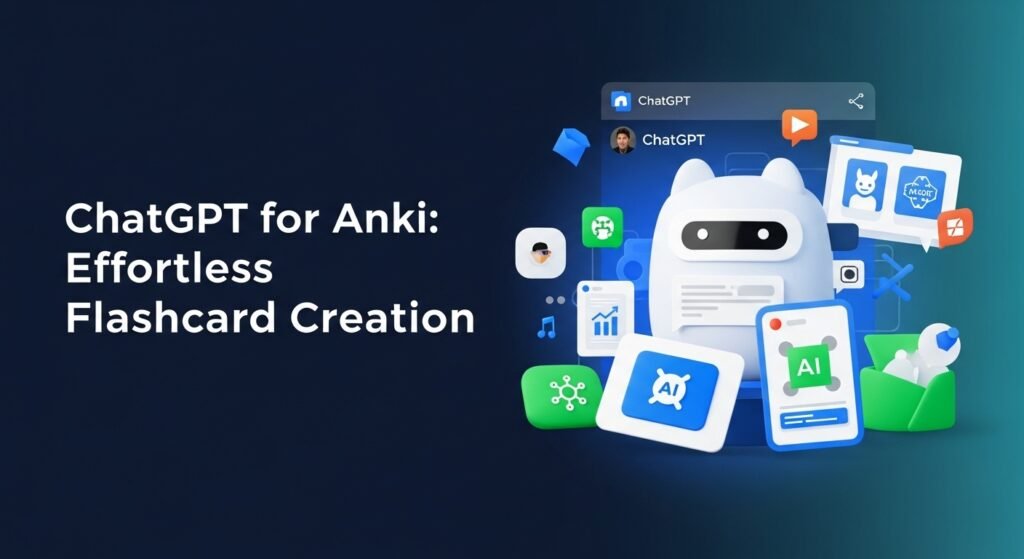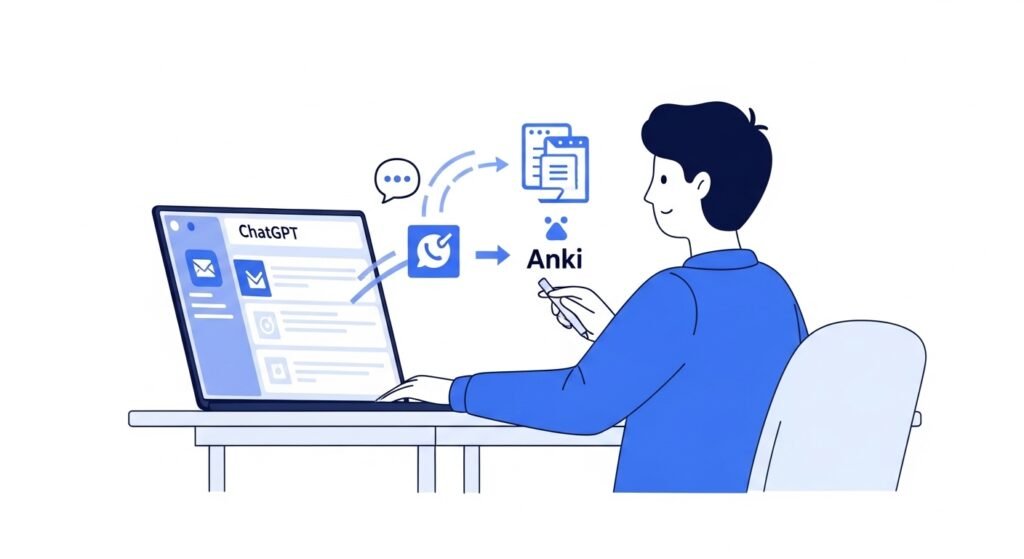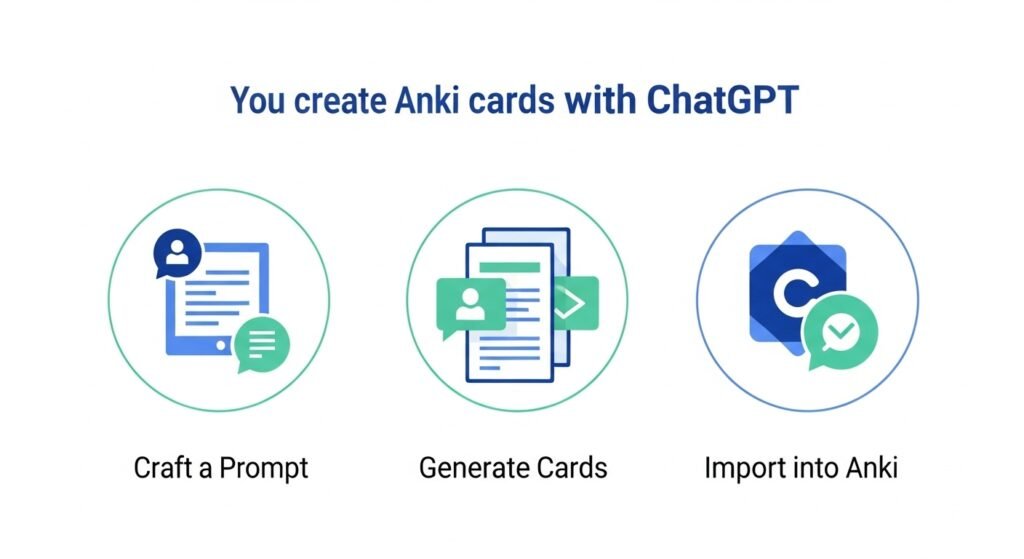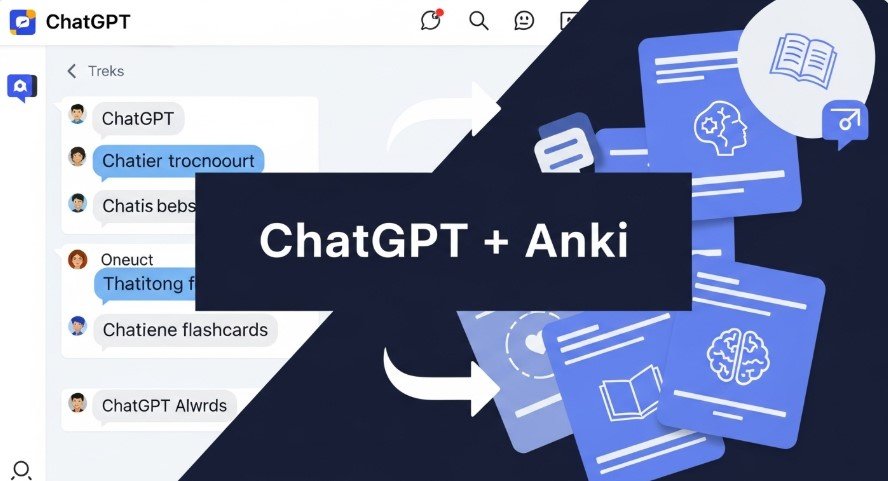Creating flashcards for Anki can be time-consuming, especially for students or professionals with heavy study loads. ChatGPT, an AI tool by OpenAI, can help by generating flashcards quickly. This guide explains how to use ChatGPT to create Anki cards, its benefits, and tips to make it work best. Whether you’re studying medicine, languages, or preparing for exams, this method can make studying easier.

What Are Anki and ChatGPT?
- Anki: A free app that uses spaced repetition to help you memorize facts. It’s popular for medical students, language learners, and anyone needing to retain information long-term.
- ChatGPT: A powerful AI language model by OpenAI. It can process text, answer questions, and generate content, including flashcards for Anki.
Learn more about AI tools in How to Use ChatGPT for UX Research Plan.
Why Use ChatGPT for Anki Cards?
ChatGPT can save you hours by automating flashcard creation. Here’s why it’s useful:
- Saves Time: Generate dozens of flashcards in minutes.
- Uniform Format: Cards are consistent, making them easier to study.
- Handles Large Texts: Perfect for turning textbook chapters or notes into cards.
- Customizable: Tailor cards for specific subjects like medicine or vocabulary.
This method works well for medical students creating terminology cards or language learners building vocabulary decks.
How to Create Anki Cards with ChatGPT
You can use ChatGPT in a few ways to make Anki cards. Below are the top methods, based on user feedback and tools available as of July 2025.
Method 1: Craft a Prompt for ChatGPT
The easiest way is to use a clear prompt. Here’s an example for a medical student:
I’m a medical student using Anki. It imports flashcards from CSV files. My cards have a question (front) and answer (back). Create flashcards from my notes below. Use only the provided text, not external knowledge. Output in CSV format with two columns: front and back.
Steps:
- Copy the prompt into ChatGPT.
- Paste your notes or text below the prompt.
- ChatGPT outputs a CSV table. Save it as a .csv file.
- In Anki, go to “File > Import,” select the file, and choose the “Basic” template.
Example Output:
What is the capital of France?,Paris
What is the largest planet?,JupiterTip: Review the cards for accuracy, as ChatGPT may occasionally miss details.

Method 2: Use Tools like AnkiGPT
Tools like AnkiGPT automate the process further. You upload a PDF or text, and the tool generates Anki-compatible flashcards.
Steps:
- Visit AnkiGPT.
- Upload your study material (e.g., lecture notes or a textbook chapter).
- Download the generated CSV file and import it into Anki.
This is great for users who want a hands-off approach.
Method 3: Use ChatGPT Plus Features
With ChatGPT Plus (using GPT-4), you can use Advanced Data Analysis for better results.
Steps:
- Open ChatGPT Plus and select “Advanced Data Analysis.”
- Use a prompt like:
I’m studying Spanish. Create 50 Anki flashcards on ‘Travel Vocabulary.’ Spanish on the front, English on the back. Include single words and sentences. Output in TSV format with front and back fields, separated by tabs.
- Save the .txt file and import it into Anki via “File > Import.”
For free users (GPT-3.5), ask for CSV output and manually save it as a .csv file.

Tips for Best Results
To make high-quality Anki cards with ChatGPT, try these tips:
- Clear Prompts: Specify format (e.g., CSV), question type (e.g., factual or cloze), and subject.
- Use Examples: Add sample flashcards to your prompt, like: “Q: What is the Dead Sea? A: A salt lake between Israel and Jordan.”
- Check Accuracy: Review cards for errors, as ChatGPT can sometimes produce incorrect answers.
- Split Long Texts: Break notes into smaller chunks (under 4,500 words) to avoid context loss.
- Test Prompts: Experiment with different phrasings to get the best output.
See how to refine prompts in How to Customize ChatGPT’s Responses.
Limitations to Know
ChatGPT is powerful but has drawbacks:
- Accuracy Issues: It may generate incorrect or incomplete cards, especially for complex topics like physiology. Always verify content.
- Text Length Limits: Long texts (over ~4,500 words) may lose context. Split them into smaller parts.
- Cost for API: Using ChatGPT’s API for large-scale card creation can incur costs based on token usage.
- Manual Formatting: Free users may need to copy-paste outputs into a CSV file manually.
What Users Say
Students and learners share positive feedback:
- A Reddit user said ChatGPT saved them 2.5 hours creating medical flashcards.
- Language learners on Polyglossic praised its speed for vocabulary decks.
- Some warn about errors, especially in theoretical subjects, so double-checking is key.
For more insights, visit Reddit’s r/Anki or email ankibrain@rankmd.org for help with the AnkiBrain extension.
Conclusion
ChatGPT can transform how you create Anki flashcards, saving time and effort. By using clear prompts, tools like AnkiGPT, or ChatGPT Plus, you can generate effective study cards for any subject. Always review the output to ensure accuracy. Try it today and make studying faster and easier!
Curious about other AI study tools? Check ChatGPT vs. Semrush: SEO Optimization.
